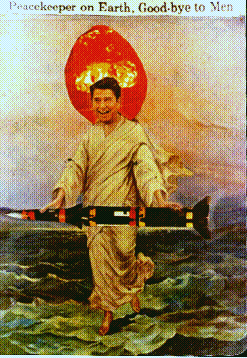Pledge of Resistance
Iowa Idea
Spring/Summer 1985
"I had the pleasure of representing our local United Mine Workers Union in the national convention. . . and introduced a resolution favoring the adoption of international socialism. We got so prominent that they called it the IOWA IDEA. -G.H. Freyhoff of Mystic, Iowa, February 7, 1903.

These and many other signs in Lafayette Park in Washington D.C. stand facing the White House for Nancy's and Ronnie's daily inspection.
24 HOUR A DAY, 4 YEAR
WHITE HOUSE ANTI-NUCLEAR VIGIL
Today in front of the White House (across the street from the White House lies Lafayette Parks two worlds are joined and separated by Pennsylvania Avenue.
On the South side in the mansion at 1600 Pennsylvania Avenue live Ronald and Nancy Reagan. Across the street without address or visible means of support, live a woman and a man known as Concepcion Picciotto and William Thomas. They began their vigil there on June 1st, 1981, and are there till the present.
Mr. and Mrs. Reagan live well housed and well fed. The crumbs from their table feed Concepcion and Thomas for a week. They live under the stars, exposed to rian and snow, summer and winter, without tent or sleeping hag. They feed like the pigeons in the park, on what comes along, sometimes from the Mc Donald's or Hardees dumpsters.
Mr. Reagan, across the street issues moral messages against abortion and an Evil Empire, for freedom, the market, and school prayer.
Concepcion and Thomas tend their messages night and day. These messages line the side walk farina the White House, signs of all sizes and shapes, in various colors, with drawings of the mushroom cloud or skulls. Angled side, the signs stand like a moral Maginot Line resisting the White House.
The Police harass Concepcion and Thomas, and they have been arrested innumerable times, Thomas was severely beaten by Park Police officer David Haynes while Thomas was taking photo graphs of Officer Haynes assaulting another protestor who was handcuffed. Concepcion was forcefully strip-searched 'and suffered defamation of character by the said officer. The signs were confiscated and broker. They came back and defended their rights to free expression in the courts, making more signs, clIng ing to their turf. They sleep little, by snatches. If the police catch them asleep they will he charged with camping.
Although the insist they are not camping, but exerci zing their right to "speak out" against the forms of political and technical insanity which presently threaten all Life on Earth, ultimately their problems are the Government's problems, their complaints the complaints of us all, as they stand before the Goliath of rights denied.

 It's the kind of place where the champion demonstrators of the western world congregate 24 hours a day throughout the year, to make their views known to the president, who lives just across the street
It's the kind of place where the champion demonstrators of the western world congregate 24 hours a day throughout the year, to make their views known to the president, who lives just across the street


 THE NORTH IRELAND TIMES
THE NORTH IRELAND TIMES Beaten, abused, living rough, they stand like some moral Maginot Line on a permanent White House peace vigil...
Beaten, abused, living rough, they stand like some moral Maginot Line on a permanent White House peace vigil... These and many other signs in Lafayette Park in Washington D.C. stand facing the White House for Nancy's and Ronnie's daily inspection.
These and many other signs in Lafayette Park in Washington D.C. stand facing the White House for Nancy's and Ronnie's daily inspection. 

